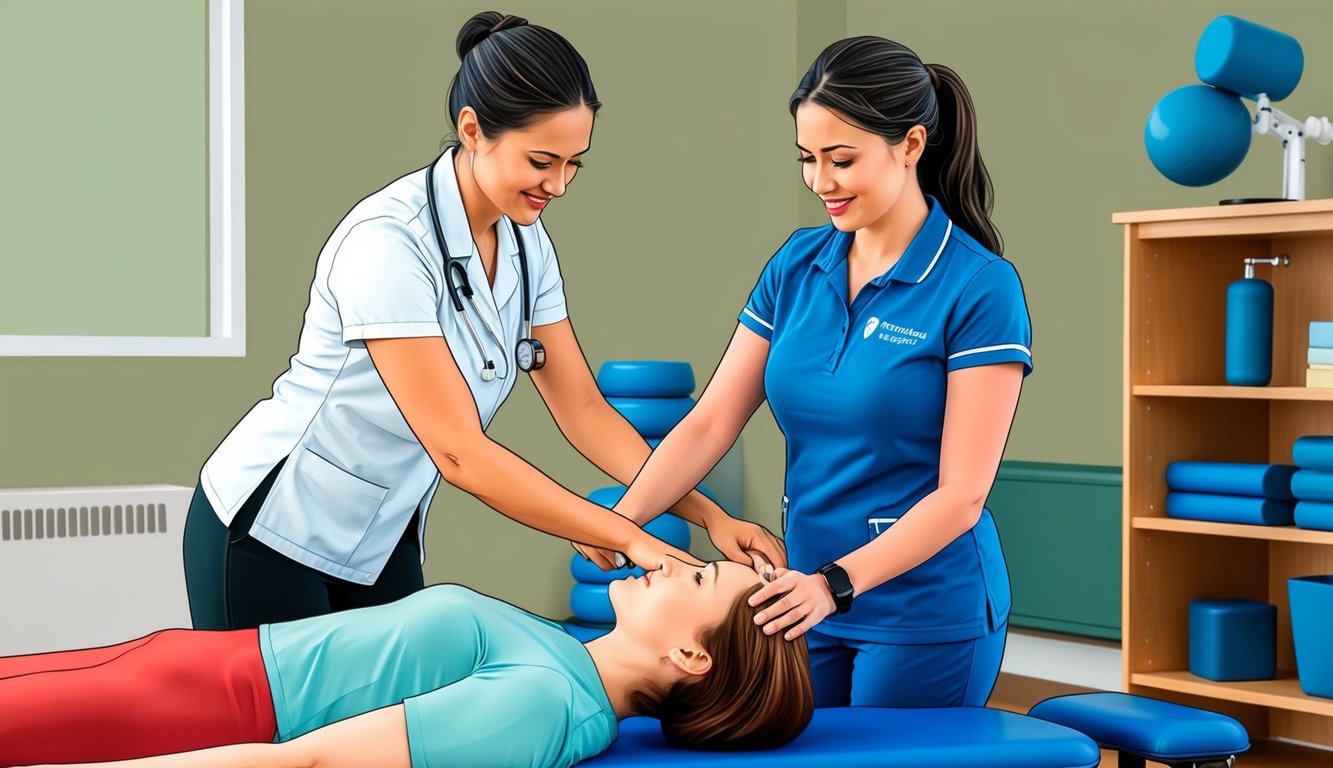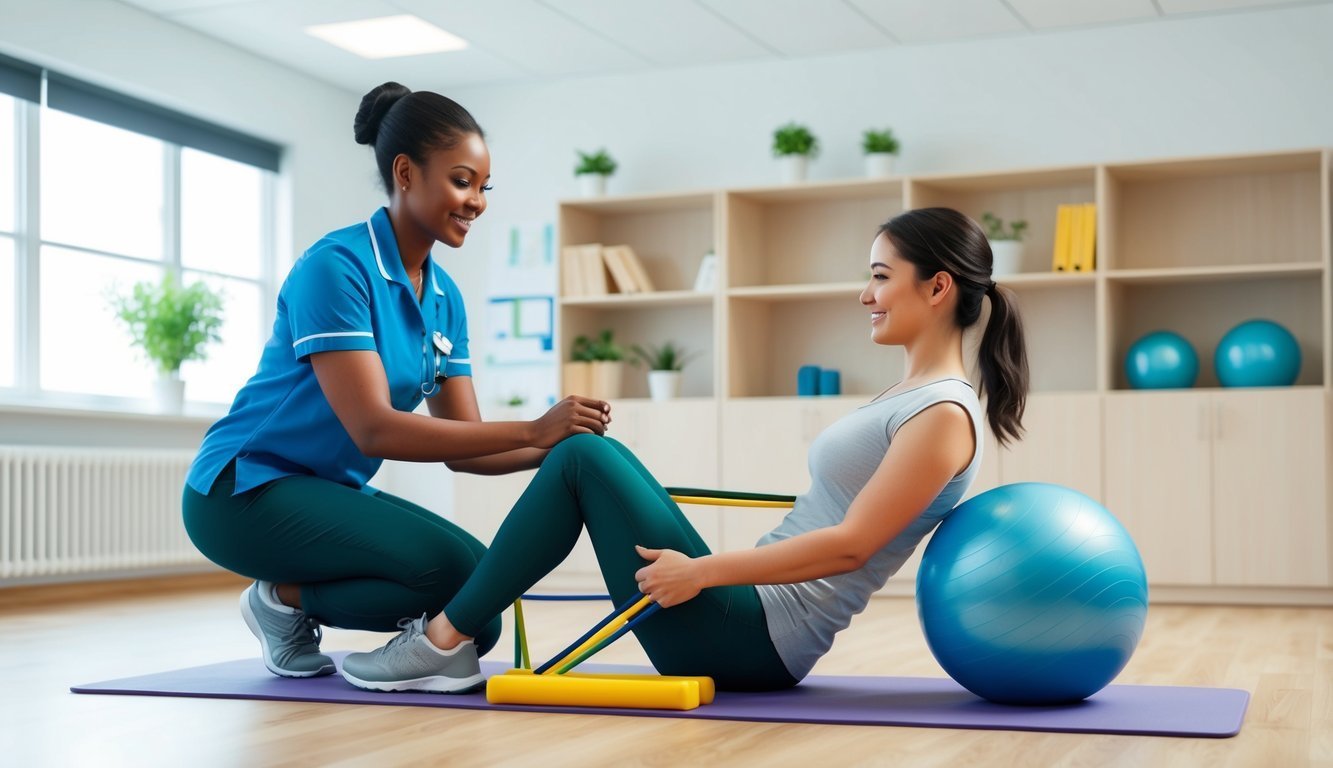Becoming a physical therapy aide is an excellent choice if you want to work in healthcare and help people recover from injuries.
Typically, you need a high school diploma and some training in the field.
This role not only allows you to assist physical therapists, but also provides you with valuable experience in the medical environment.
Physical therapy aides often perform tasks such as preparing treatment areas, assisting with patient exercises, and maintaining equipment.
You will learn essential skills that can help you advance your career in healthcare.
Many aides go on to further education and certifications, opening doors to becoming physical therapist assistants or exploring other specialties.
This guide will take you through the steps to become a physical therapy aide, including the necessary education, skills, and career opportunities in the field.
By the end of the article, you’ll have a clear path laid out for your journey in this rewarding profession.
Key Takeaways
- A high school diploma and related training are essential to start.
- Important skills include communication and the ability to work well with patients.
- Career advancement opportunities are available through further education.
Understanding the Role of a Physical Therapy Aide
As a physical therapy aide, you play a crucial role in supporting patient care and helping healthcare professionals.
Your responsibilities range from working directly with patients to managing administrative tasks in treatment rooms.
Job Description and Responsibilities
In your role as a physical therapy aide, you assist patients with exercises and therapeutic activities.
This includes helping them perform specific movements and maintaining proper form.
You may also set up equipment and clean treatment areas.
Key Responsibilities:
- Support patients during therapy sessions
- Prepare treatment rooms and equipment
- Document patient progress and report to therapists
- Perform administrative tasks like scheduling appointments
Effective communication is essential.
You interact with patients and healthcare professionals to ensure a smooth therapy process.
Your support helps enhance the quality of patient care.
Work Environment and Collaboration with Healthcare Professionals
You typically work in various settings, such as hospitals, outpatient clinics, or rehabilitation centers.
Your work environment focuses on providing safe and supportive care.
Collaboration is important.
You will work closely with physical therapists and other healthcare professionals.
This teamwork helps in:
- Creating tailored treatment plans
- Monitoring patient progress
- Adjusting therapy based on individual needs
In this role, adaptability and strong communication skills are key to ensuring effective patient care.
Your contributions are vital to a successful rehabilitation process.
For more on this career, you can visit Nurse.org.
Educational Pathways and Certifications
To become a physical therapy aide, you need a strong educational foundation and specific training.
This section covers the important steps in high school preparation, education programs, and certification requirements.
High School Preparation and On-the-Job Training
Your journey starts with obtaining a high school diploma or GED.
Taking courses in biology, anatomy, and physiology is essential.
These subjects give you a basic understanding of the human body, which is crucial for your future role.
On-the-job training is another important aspect.
Many employers offer training programs that allow you to learn the skills needed for the job while working.
This experience helps you become familiar with the day-to-day tasks of a physical therapy aide and builds your confidence in the workplace.
Postsecondary Education and Physical Therapy Aide Program
After high school, consider enrolling in a physical therapy aide program at a community college or technical school.
These programs often include courses in anatomy, physiology, and kinesiology, focusing on the skills needed to assist physical therapists effectively.
During these programs, you’ll learn how to assist patients with exercises, manage equipment, and maintain treatment areas.
Many programs include hands-on training, which is invaluable for real-world experience.
Completing a formal education program not only enhances your skills but also makes you a more competitive candidate in the job market.
Certification Requirements and Continuing Education
To stand out as a candidate, seeking certification is beneficial.
The Certified Physical Therapy Aide Specialist (CPTAS) designation shows that you have met specific educational and training standards in the field.
Certification may require you to pass an exam, covering essential topics in physical therapy care.
Moreover, continuing education is important for career growth.
Many employers prefer candidates who participate in ongoing training to stay current with industry practices.
Look for workshops or courses that enhance your knowledge and skills.
Engaging in continuing education ensures you’re aware of the latest treatments and techniques in physical therapy.
Essential Skills and Qualifications

To succeed as a physical therapy aide, you need specific skills and qualifications that enhance your ability to support patients and therapists.
Focus on mastering the knowledge areas and interpersonal skills that build a solid foundation for this role.
Anatomy and Physiology Knowledge
A strong understanding of anatomy and physiology is crucial.
You should know the main body systems, common injuries, and recovery processes.
This knowledge helps you assist in treatments effectively.
Familiarize yourself with terms like muscle groups, joint movements, and rehabilitation protocols.
This will enable you to answer basic questions patients may have.
Consider taking courses or certifications that cover these topics.
An excellent resource is the National Center for Biotechnology Information for accessible medical information.
Communication and Interpersonal Skills
Effective communication is key in your role.
You need to explain exercises clearly and listen actively to patient concerns.
This builds trust and ensures that patients feel supported during their recovery.
Active listening is important.
It allows you to understand patients’ needs and respond correctly.
Use empathetic language to show compassion and reassure patients.
Interpersonal skills also involve working with therapists and other healthcare staff.
Cultivate teamwork skills, as collaboration enhances the overall care experience.
Physical Stamina and Mobility Assistance
Your job as a physical therapy aide demands physical stamina.
You may be required to assist patients in mobility exercises or lift equipment.
Being physically fit helps you perform these tasks safely and efficiently.
Grow your physical strength through regular exercise.
This is beneficial for both your career and personal health.
Understand basic CPR techniques to ensure safety in emergency situations.
Knowing how to assist patients with mobility issues is also important.
Familiarize yourself with different types of mobility aids to provide proper support.
Specializations and Areas of Practice

Physical therapy aides play a vital role across various specializations.
Each area focuses on different patient needs and treatment methods, allowing you to assist in tailored care.
Orthopedic, Geriatric, and Cardiovascular Care
In orthopedic care, you will help patients recovering from surgeries, fractures, or joint replacements.
Your role may include preparing equipment and assisting in exercises that improve mobility and strength.
Geriatric care focuses on elderly patients dealing with age-related issues.
You’ll support them with exercises that enhance balance, strength, and flexibility, which can reduce fall risks.
Cardiovascular care involves helping patients with heart and circulation issues.
You will aid in rehabilitation programs designed to improve heart health through monitored exercise and conditioning.
Pediatric and Sports Rehabilitation
Pediatric rehabilitation targets children with developmental delays or injuries.
You assist in activities that promote physical growth and coordination.
Your role is critical in creating a supportive environment for young patients.
Sports rehabilitation helps athletes recover from injuries and improve performance.
You will work with specialized treatments focused on specific sports-related injuries, aiding with exercises that restore strength and flexibility.
Oncology, Neurology, and Chronic Condition Management
In oncology, you assist cancer patients with physical therapy designed to reduce treatment side effects and improve function.
Your support is essential for patients returning to daily activities.
Neurology focuses on patients recovering from strokes or other neurological conditions.
You help implement therapies that improve motor skills and coordination, playing a crucial part in their rehabilitation.
Chronic condition management involves supporting patients with ongoing health issues like arthritis or diabetes.
You assist with exercises and education that empower them to lead more active lives.
Career Outlook and Progression
The career outlook for physical therapy aides presents promising job growth, competitive salaries, and several pathways for advancement in the field.
Understanding these aspects can help you make informed decisions about your career trajectory.
Job Outlook and Market Trends
According to the U.S. Bureau of Labor Statistics, employment for physical therapy aides is projected to grow 19% from 2023 to 2033.
This rate is much faster than the average for all occupations.
Factors driving this growth include an aging population and increased demand for rehabilitation services.
As healthcare needs rise, job openings for physical therapy aides will reach approximately 27,500 each year.
You may find opportunities in various settings, including hospitals, clinics, and rehabilitation centers.
Median Annual Salary and Employment Statistics
The median annual salary for physical therapy aides is approximately $33,000.
Salaries can vary based on factors like experience, location, and employer.
Here’s a breakdown of salary ranges based on experience:
| Experience Level | Salary Range |
|---|---|
| Entry-Level | $25,000 – $30,000 |
| Mid-Level | $30,000 – $40,000 |
| Experienced | $40,000 – $50,000+ |
As job demand continues to increase, many aides can expect salary growth as they gain experience.
Additionally, certain regions may offer higher pay to attract workers.
Advanced Proficiency Pathways and Career Advancement
To advance your career as a physical therapy aide, consider pursuing further education or certifications.
This can open doors to roles such as physical therapy assistant (PTA) or specialized therapy roles.
Common pathways include enrolling in an accredited PTA program where you will learn essential skills like anatomy and patient care techniques.
Pursuing advanced proficiency through continued education can enhance your job prospects and earning potential.
Staying updated with industry trends and gaining certifications in specialized areas can significantly benefit your career growth.
Consider exploring professional organizations for networking and training opportunities.
Frequently Asked Questions
This section addresses common inquiries regarding the path to becoming a physical therapy aide.
It covers educational requirements, certification, job search strategies, salary expectations, primary responsibilities, and the differences between aides and assistants.
What are the educational requirements for a physical therapy aide?
To work as a physical therapy aide, you typically need a high school diploma or GED.
Additional training can be gained through specific programs that offer courses related to physical therapy.
Enrolling in a physical therapy aide program can enhance your skills and marketability.
What type of certification is needed to become a physical therapy aide?
Certification is not always required to become a physical therapy aide.
However, obtaining a relevant certification can make you more competitive in the job market.
Consider looking into programs that offer certification options like the Certified Physical Therapy Aide Specialist (CPTAS).
How can one find physical therapy aide jobs?
You can find physical therapy aide jobs through various methods.
Online job boards, healthcare career websites, and local hospital listings are great starting points.
Networking with professionals in the field and joining relevant associations may also help you discover job openings.
What is the average salary for a physical therapy aide in the United States?
The average salary for a physical therapy aide in the United States typically ranges from $25,000 to $35,000 per year.
Factors affecting salary include location, experience, and the type of healthcare facility.
You can find more specific salary information by checking job platforms.
What are the primary responsibilities of a physical therapy aide?
Physical therapy aides support physical therapists.
They prepare treatment rooms, assist with equipment, and help patients during their sessions.
They also perform clerical duties and maintain patient records.
Effective communication with both patients and therapists is essential.
How does the role of a physical therapist aide differ from that of an assistant?
The primary difference lies in the level of responsibility and training.
A physical therapy aide typically performs supportive tasks and does not conduct treatments.
In contrast, a physical therapy assistant (PTA) has more training and can directly assist in patient care under a physical therapist’s supervision.

